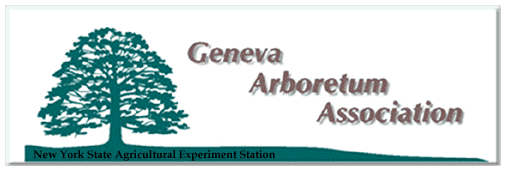

Our campus
has on its grounds two stunning representatives of the Fagaceae, or beech
family. These lovely trees bring shade, color and contrast to our campus
throughout all four seasons and are particularly a nice addition to the
fall landscape with their purple bronze to copper fall coloring, triangular
nuts covered by spiny bracts, smooth blue grey bark and long, narrow, sharp-pointed
buds. Both are massive and magnificent in outline: the European purple leaf
beech (Fagus sylvatica purpurea) on the lawn of Parrott Hall, and
the European cut-leaf beech (Fagus sylvatica laciniata) in the northern
section of the Rock Garden. A recent campus addition is a very young European
fern leaf beech (Fagus sylvatica asplenifolia) on Hedrick Hall's
south lawn planted in memory of George MacDonald, Horticultural Sciences.
As the names imply, all three campus beeches are imports horticultural varieties
of European beech, one of the most popular large shade trees in the US.
This tree was probably introduced to North America during colonial times
as a potential timber tree. Varieties of European beech include purple,
copper, cutleaf, fernleaf, oakleaf, roundleaf foliage types and both weeping
and columnar forms. European beech is an important hardwood in its native
range, making extensive forests, just as our American beech (Fagus grandifolia),
does here in the Northeast. Colonists were quick to recognize this American
cousin, a handsome tree with similar edible nuts.
The beech family has 8 genera and between 700-900 species nearly distributed
world-wide. Five genera are native to North America: beech, chestnut, oak,
chinkapin, and tanoak. Sixty-six trees and ten shrub members of Fagaceae
are native or naturalized in the US. Fossil records indicate this is an
old group and was in the past much more widespread than it is now. Its beech
members are slow growing, long-lived trees, reaching 100 ft in height, 11.5
ft in diameter and 300-400 years in age. We also have several fine representatives
of the oak family on campus.
F. sylvatica, our native American beech, is a large deciduous tree
with a clear, straight, massive trunk, long, spreading branches, a rounded
crown and simple, alternate leaves. American beech can be distinguished
from European beech as its blue green leaves have 9-14 pairs of veins per
leaf while European beech has only 5-9 pairs per shiny, dark green leaf.
American Beech leaves turn a lovely yellow-gold in the fall, and often persist
on the tree throughout the winter.
Male and female beech flowers are borne separately on the trees. Male beech
flowers are grouped together in globe shaped heads clustered along elongate,
slender catkins (aments!). Female flowers are borne in 2 to 4 flowered spikes
on short stalks at or near branchlet tips. Flowers appear in late April
to early May.
Beech nuts serve as food for people, livestock, and wildlife. They mature
and drop by the first heavy frost each year, providing a pre-winter food
supply. Heavy crops of seeds occur every 2-3 years. The edible nuts are
triangular sided, yellow to pinkish brown and were used for oil and ground
as a coffee substitute. Beech bark and leaves however, may be poisonous
to both people and animals.
Beech wood is hard, tough and strong, taking a beautiful finish, It is used
primarily for interior trim, furniture and floors. Superstition has it that
beeches planted near a house can keep away lightning. There may be some
truth to this idea as records show that beeches are struck by lightning
less often than are other trees, perhaps due to the high oil content of
the trunk.
Beech can be found on a wide variety of soils, but requires more moisture
than do many other hardwoods. Along with sugar maple, American beech is
the most tolerant of the northern hardwoods. It reaches its largest sizes
in the Ohio and Mississippi River valleys on alluvial bottom land soils.
These slow growing, shallow-rooted trees may form many root suckers resulting
in clumps or groves throughout their range.
Unlike most trees, beech retains its smooth bark in old age. The word "beech"
is of very ancient origin and signifies "book"- (both come from
same root word). Early writings of the Germanic peoples (Saxons and Germans)
consisted of runic characters written on tablets of this wood. Gutenberg
carved his movable type for the first machine-printed Bible from beech wood.
From Roman times this tree has been a popular graffiti tree, as seen in
the Latin proverb "Crescent illae; crescentis amores" or
"as these letters grow, so may our love grow," referring to initials
of lovers carved into beech bark. Regrettably, beech bark remains today
as a favorite writing material for carving and preserving dates and initials,
along with other less savory messages.
by Cathy Heidenreich
Next (Burning bush)
Return to Arboretum Home Page
Return to NYS Agricultural Experiment Station Home Page
Page maintained by tnb1@cornell.edu
Last modified January 21,1998
http://www.nysaes.cornell.edu/arboretum/l_tulipifera.html